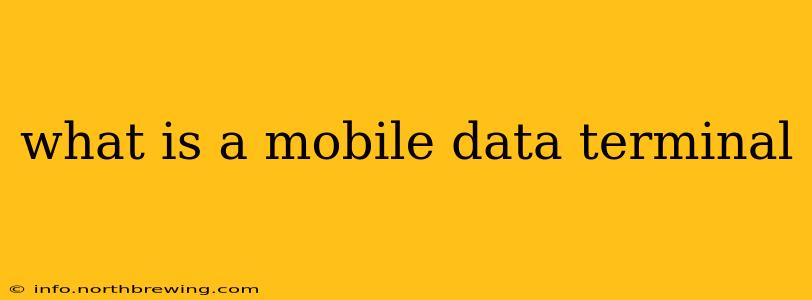A Mobile Data Terminal (MDT) is a device that allows for the transmission and reception of data while in motion. Think of it as a mobile computer specifically designed for use in vehicles or other mobile environments, providing real-time access to information and communication systems. Unlike a simple smartphone, MDTs are typically ruggedized to withstand harsh conditions and offer specialized features tailored to specific industries. This guide will delve deeper into what constitutes an MDT, its applications, and key features.
What are the key features of a Mobile Data Terminal?
MDTs are more than just rugged tablets or laptops. Their core functionality revolves around reliable data communication and specialized features to enhance productivity in mobile environments. Key features often include:
- Robust Design: MDTs are built to endure vibrations, shocks, extreme temperatures, and dust, making them ideal for demanding environments like construction sites, emergency vehicles, or delivery trucks.
- Secure Communication: Data security is paramount. MDTs usually incorporate encryption and other security protocols to protect sensitive information during transmission and storage.
- GPS Integration: Precise location tracking is crucial for many MDT applications. Integrated GPS provides real-time location data, often integrated with mapping software.
- Connectivity: Multiple connectivity options are vital, including cellular data (4G LTE, 5G), Wi-Fi, and sometimes satellite communication for areas with limited cellular coverage.
- Specialized Software: MDTs are frequently paired with specialized software applications tailored to the specific industry. This might include dispatch software, route optimization tools, or inventory management systems.
- Large, Readable Displays: Given their use in often challenging visual conditions, MDTs usually feature bright, high-resolution displays that remain easily readable even in direct sunlight.
- Input Methods: Depending on the application, MDTs may utilize a variety of input methods, such as touchscreens, keyboards, and barcode scanners.
What are some common applications of Mobile Data Terminals?
The applications of MDTs are wide-ranging and span numerous industries. Some key examples include:
- Transportation and Logistics: Delivery drivers, truckers, and transportation companies use MDTs for route optimization, delivery tracking, and communication with dispatchers.
- Emergency Services: Police, fire, and ambulance services utilize MDTs for real-time location tracking, dispatch management, and access to critical information during emergency response.
- Field Service: Technicians and field service personnel use MDTs to access work orders, track inventory, and communicate with dispatch.
- Construction and Utilities: Workers in these industries use MDTs for project management, equipment tracking, and safety reporting.
- Public Safety: Law enforcement, security personnel, and other public safety officials use MDTs for communication, data access, and crime scene management.
What are the different types of Mobile Data Terminals?
MDTs come in various form factors to meet specific needs:
- Rugged Tablets: These are the most common type, offering a balance of portability and robustness.
- Vehicle-Mounted Terminals: These are fixed in vehicles and offer enhanced durability and larger displays.
- Handheld Terminals: Smaller and more portable, these are ideal for applications where mobility is paramount.
How does a Mobile Data Terminal differ from a smartphone?
While both smartphones and MDTs can access data on the go, key differences exist:
- Durability: MDTs are designed to withstand harsh environments, significantly exceeding the robustness of most smartphones.
- Specialized Software: MDTs are often paired with industry-specific software, enhancing productivity in specific roles.
- Connectivity: MDTs might offer more robust connectivity options, including satellite communication, crucial in areas with poor cellular coverage.
- Display and Input: MDTs generally offer larger, brighter displays and more robust input methods better suited to demanding work environments.
What are the benefits of using a Mobile Data Terminal?
Employing MDTs offers several significant benefits:
- Increased Efficiency: Real-time access to information and communication streamlines workflows and improves productivity.
- Improved Communication: Instant communication between mobile workers and dispatch or headquarters enhances coordination and response times.
- Enhanced Data Accuracy: Automated data collection reduces manual entry errors and improves data integrity.
- Better Decision-Making: Real-time data provides insights for better informed decisions in dynamic situations.
- Reduced Costs: Improved efficiency, better coordination, and reduced errors contribute to significant cost savings in the long run.
In conclusion, Mobile Data Terminals are powerful tools that enhance communication and data management in mobile environments across numerous industries. Their rugged design, specialized software, and robust connectivity make them invaluable assets for improving efficiency, safety, and overall productivity.
